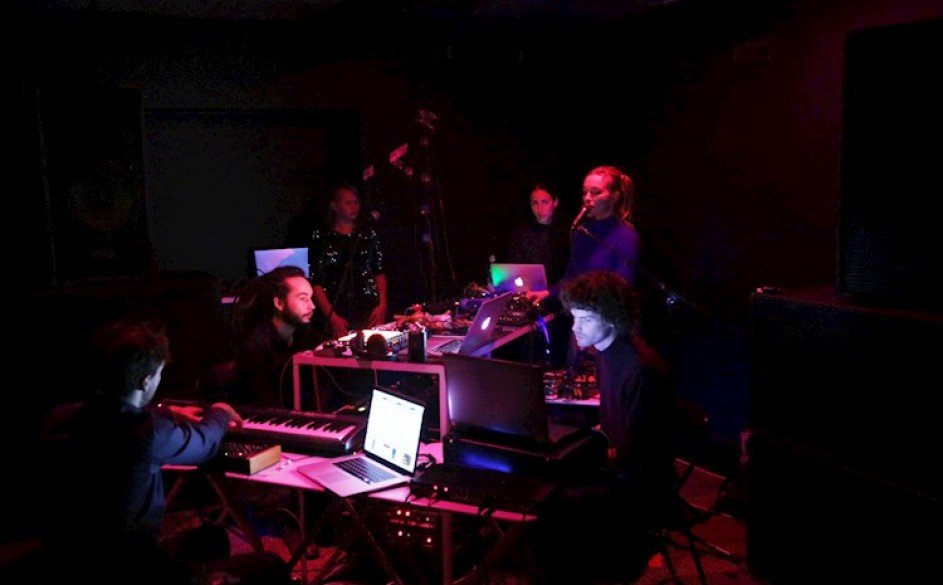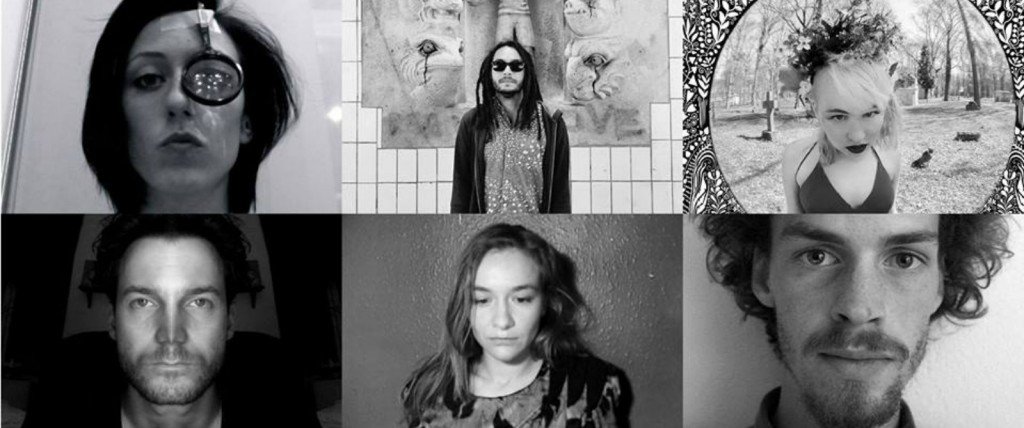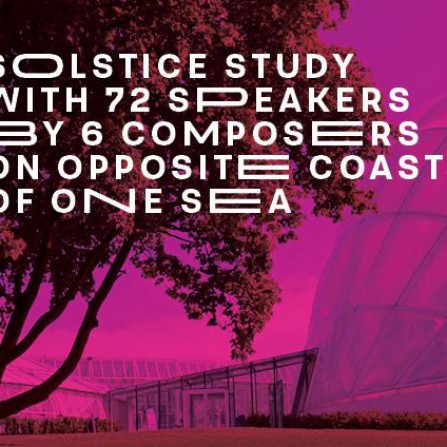Sound art – an artistic hybrid
Sound art is increasingly becoming a buzz word in today’s world of culture. But how do you define it and which consequences does it have for the conventional perception of music and visual art as two separate disciplines? Finally, why and how is the notion of sound art interesting to explore in the intercultural meeting of Danish and Baltic culture?
Sound art – definition and reflection on the term
How does one define the concept of sound art? One could think that “sound art” refers to art made of sound, but it is not entirely as simple. Sound art is an interdisciplinary branch of contemporary art, where sound is serving as the medium as well as the source of the work of art. The purpose of sound art is to fuse sound and space. The sound can be of acoustic, electronic or an entire different type of music as well as environmental and various non-musical sound. The engaging objects of art can be film, sculpture, the human body and other kinds of contemporary art subjects.
Because of its versatile nature, there is an ongoing discussion about which artistic box, sound art goes into; because of its sonic qualities some experts place sound art under the notion of experimental music, while others qualify sound art as belonging to the visual art. A third option is to consider sound as form of hybrid. A hybrid of music, sound and visual arts that all complement each other in a way that gives the audience multidimensional experience. This approach is the one seen in both Latvia and Denmark, where there are several platforms working with the concept of sound art as a mixture between visual and sonic art.
Latvian-Danish sound art collaboration
The field of sound art has been a key component for collaboration between Denmark and Latvia. Throughout the years there have been various exhibitions and installations all unique in their own way.
Jacob Kirkegaard – Labyrinthitis
In a four year period, the Danish sound artist and composer Jacob Kirkegaard has visited Latvia on several occasions. In 2008 his work Labyrinthitis was presented as the Danish contribution to the Museum Night in Riga.
The title Labyrinthitis refers to the medical term for the syndrome caused by a disorder in the maze of the inner ear, affecting the spatial navigation and balance control. Under normal circumstances, it is impossible for humans to hear the sounds of one’s own ears, but Kirkegaard made it possible. Through ultra-small loudspeakers, tones of different frequencies were sent into the ears of Kirkegaard and as the basilar membrane in the cochlea was stimulated, his ears started to generate tones. These tones and the process that produced them constitute the basic components of Labyrinthitis. The listener is part of an interactive concert where hers/his own ears react on the tones that are played. The room is transformed into a resonating labyrinth made out of sounds.
Voldemārs Johansons and Christian Skjødt – Monument to the Ocean Storm
In 2015, Danish Cultural Institute commissioned two sound art installations by Danish artist Christian Skjødt and Latvian artist Voldemārs Johansons for the 25th anniversary of the Danish Cultural Institute in Latvia.
The collaboration resulted in a visual and sonic installation called Monument to the Ocean Storm.
The two installations were an interactive art work. Placing the audience ‘in the middle of the storm’ the project offered a truthful experience of ocean storms of the Northern Sea, which Johanson recorded on the Faroe Islands.
Working with speakers Skjødt’s installation interpreted a piece by the renowned Danish 20th century composer Carl Nielsen, celebrating his 150th birthday. The installation split a recording of Nielsen’s string quartet in F-mol (op. 5) for the audience to ‘step into’.
Christian Skjødt – Illumination
As part of the sound art festival SKAN II in 2014, Christian Skjødt created a site-specific installation for the 18th century wine cellar in the botanical garden of Riga – ILLUMINATION. It consisted of a series of autonomous analogue systems that operate and execute the auditive translations. Inspired by the natural surroundings of the botanic garden and acoustics of the cellar the work examined the translation of the outer circumstances, harvesting the energy from the sun, and bringing this into the cellar in the form of sound.
The above mentioned are all examples of how sound art is used as art installations and examples of how to approach sound art as part of the visual art branch of contemporary art.
There are also examples where sound art is object to the other theoretical approach – where it is seen as being part of sonic art. In this approach, the sound art is taken out of its exhibition frame – out of the museum as constellation – and is brought in to the music scene as part of the music performance of a concert.
This is the practice of two music platforms: Skaņu Mežs (creators of the SKAN II festival) in Latvia and RADAR in Denmark.
RADAR
Radar, is an experimental platform that mixes music with other artistic genres, in attempt to rethink the frame of concerts and artistic presentation. In his years of working in the business of music Martin Aagaard sees great potential in RADARs crossover work with music and sound art.
Martin Aagaard is a Danish project coordinator at the music venue RADAR, and DCI met with him for an interview about his work with the Latvian music venue Aristīds and all the benefits of a cross-cultural collaboration.
Combining sound art with the conventional concerts form is not common in the Danish music scene and sound art is more often seen at exhibitions and museums than as part of a concerts. Martin Aagaard wants to change this. By adding elements of artistic installations to concerts, RADAR wants artists, technicians and the audience to rethink the whole constellation of a concert. It wants to open up for interdisciplinary experimentation.
The idea is to include elements in their concert setups that combine both the location of the stage, the light and other part of the venue to give a dramatic narrative composition and create a sensuous and multidimensional concert experience. This should encourage bands to start thinking along the lines of combining art and sound so that it will become a natural part of the future planning of concerts.
This idea was at the very heart of the project when the Latvian-Danish collaboration was initiated.
Aristīds is a music venue located in the old halls of Riga Black Balsam factory, situated in the outskirts of Riga’s Central District. The place is dedicated to underground subversive art and music, situated not far from the buzzing creative district of Miera iela. Aristīds’ approach to the concept of concerts is slightly different from the conventional attitude and this is why the collaboration with RADAR was ideal. The meeting of the two music platforms opened up for Fabrice Praz and Martin Aagaard to deliberate the concert constellation and exchange knowledge and experience. The merge of artists, music venues and practices led to a greater discussion on the concert format and its possibilities. It opened up a possibility of rethinking the entire concert concept and permitted both artists and music platforms to think outside the box of the conventional concert form and go beyond the traditional framework of the concert.
In cooperation with Danish Art academies, RADAR wishes to include visual artists in implementing sound art in the setting of concerts. This has led to an important collaboration with the Latvian sound art festival Skaņu Mežs. As Martin Aagaard puts it:
“Our joint work with Skaņu Mežs is of great importance to RADAR. Skaņu Mežs is a significant source of inspiration in how to communicate sound art as a music venue and more specifically how to use sound art in a concert hall.”
Skaņu Mežs is in the absolute top of European sound art festivals. Since 2003, the festival has offered festival goers an insight into the latest developments within modern music and alternatives to the conventional perception of the notion of culture. It is a platform for a large range of music genres and explores new languages in music and sound through its combination of concerts with exhibitions on audio-visual art as well as sound art.
RIGA X AARHUS
The initiative of collaboration between Denmark and Latvia concerning sound art has already been successful. In late February 2016, three artists from Aarhus (Olga Szymula, Filip Johan Arnestad and Merlyn Silva) and three artists from Riga (Sabīne Moore, Anna Ķirse and Toms Auniņš) came together at the music venue Aristīds in Riga. It was initiated by Danish Cultural Institute in Estonia, Latvia and Lithuania together with RADAR.
Through a two day workshop, they transformed the place into a sonic Exploratorium and joined forces in a Latvian-Danish music development. A few months later, the six artists met up again – this time at the premises of RADAR, in Aarhus. During another two day workshop, they composed and made music that was presented to a live audience on the 27th of May. The full-length concert can be streamed through RADARs webpage.
The group worked throughout 2016 and the collaboration will culminate in Aarhus in June 2017. As Aarhus is one of the two winners of the European Capitals of Culture initiatives 2017. The concert/event will be held at Væksthusene (the Greenhouse), where the six artists will have transformed the giant greenhouse into a complete sound art installation.
The artists and their individual sound can be explored here.

Concert at Skaņu Mežs Festival 2016.
The significance of the collaboration between Denmark and Latvia
Martin Aagaard emphasizes that the sound art collaboration between Riga and Aarhus is rewarding: “This collaboration creates links between people on so many levels” and he expresses surprise that this cooperation has created as many contacts and networks as it has.
The joint work between Riga and Aarhus is beneficial on especially two levels: for the music venues and especially for the artists. For the platforms, RADAR and Skaņu Mežs, the collaboration has opened doors to an indispensable exchange of knowledge on the field of sound art and also a cross cultural exchange of practices in the two countries. It has offered a great insight into how one curates and collaborates across boarders as well as across institutional differences.
For the musicians, the collaboration has also been of significant importance. The project has built a connection between Latvian and Danish artists and it has permitted the artists to exchange creativity and knowledge in the fields of creating music and sound art. More so, the cross-cultural interchange has also worked as a stepping stone for the individual artist.
An examples is Latvian Sabine, who is studying Visual Arts in Riga. In Latvia, there is not an education specifically pointed at sound art, but there is in Denmark. At the Danish National Academy of Music, it is possible to do a master’s degree in Electronic Music and Sound Art and she is now looking into the possibilities of moving to Denmark to study sound art.
Another example is Olga from Aarhus, who hopes that the cooperation with Skaņu Mežs in October will make it possible for her to tour the Baltic States and further on, after their joint event in Riga.
In answering the final question of why and how sound art is interesting for intercultural meetings, on could say that it is because of the intercultural learning. This fusion of artistic approaches and branches opens up for a new conception of visual- and sonic art – and most importantly the combination of the two.
This crossfield of artistic meetings between art forms opens up for a similar crossfield for cultures. The shared work on sound art opens to a field of cultural encounters and permits new collaborations to grow and open doors to new ways of knowledge sharing across frontiers, cultures and artistic fields. Sound art is a cultural eye-opener – in every sense of the word.

